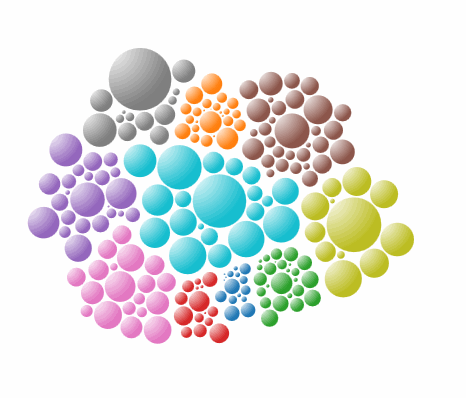з”ЁжёҗеҸҳйўңиүІз»ҳеҲ¶D3еңҶ
еҰӮдҪ•з”ЁжёҗеҸҳиүІз»ҳеҲ¶еңҶеңҲпјҹжҜ”еҰӮпјҢд»Һй»„иүІеҲ°и“қиүІзҡ„жёҗеҸҳгҖӮ
йҖҡеёёпјҢиҰҒеҲӣе»әй»„иүІеңҶеңҲпјҢжҲ‘们еҸҜд»ҘдҪҝз”Ёд»ҘдёӢд»Јз Ғпјҡ
var cdata=[50,40];
var xscale=40;
var xspace =50;
var yscale=70;
var svg = d3.select("body")
.append("svg")
.attr("width", 1600)
.attr("height", 1600);
var circle = svg.selectAll("circle")
.data(cdata)
.enter()
.append("circle");
var circleattr = circle
.attr("cx", function(d) {
xscale = xscale+xspace;
return xscale;
})
.attr("cy", function(d) {
yscale=yscale+xspace+10;
return yscale;
})
.attr("r", function(d) {
return d;
})
.style("fill","yellow");
2 дёӘзӯ”жЎҲ:
зӯ”жЎҲ 0 :(еҫ—еҲҶпјҡ26)
жӮЁеҝ…йЎ»йҰ–е…ҲеңЁSVGдёӯе®ҡд№үжёҗеҸҳпјҢ然еҗҺдҪҝз”ЁSVGй“ҫжҺҘеЎ«е……жёҗеҸҳе…ғзҙ гҖӮ
// Define the gradient
var gradient = svg.append("svg:defs")
.append("svg:linearGradient")
.attr("id", "gradient")
.attr("x1", "0%")
.attr("y1", "0%")
.attr("x2", "100%")
.attr("y2", "100%")
.attr("spreadMethod", "pad");
// Define the gradient colors
gradient.append("svg:stop")
.attr("offset", "0%")
.attr("stop-color", "#a00000")
.attr("stop-opacity", 1);
gradient.append("svg:stop")
.attr("offset", "100%")
.attr("stop-color", "#aaaa00")
.attr("stop-opacity", 1);
// Fill the circle with the gradient
var circle = svg.append('circle')
.attr('cx', width / 2)
.attr('cy', height / 2)
.attr('r', height / 3)
.attr('fill', 'url(#gradient)');
еёҰжңүе®Ңж•ҙзӨәдҫӢзҡ„jsFiddleгҖӮжңүе…іеҰӮдҪ•еңЁMDN Tutorialдёӯе®ҡд№үSVGжёҗеҸҳзҡ„жӣҙеӨҡиҜҰз»ҶдҝЎжҒҜгҖӮз»“жһңеӣҫеғҸпјҡ

зӯ”жЎҲ 1 :(еҫ—еҲҶпјҡ7)
зңӢдёҖдёӢиҝҷж®өд»Јз Ғпјҡ
var width = 500,
height = 500,
padding = 1.5, // separation between same-color nodes
clusterPadding = 6, // separation between different-color nodes
maxRadius = 12;
var n = 200, // total number of nodes
m = 10; // number of distinct clusters
var color = d3.scale.category10()
.domain(d3.range(m));
// The largest node for each cluster.
var clusters = new Array(m);
var nodes = d3.range(n).map(function() {
var i = Math.floor(Math.random() * m),
r = Math.sqrt((i + 1) / m * -Math.log(Math.random())) * maxRadius,
d = {cluster: i, radius: r};
if (!clusters[i] || (r > clusters[i].radius)) clusters[i] = d;
return d;
});
// Use the pack layout to initialize node positions.
d3.layout.pack()
.sort(null)
.size([width, height])
.children(function(d) { return d.values; })
.value(function(d) { return d.radius * d.radius; })
.nodes({values: d3.nest()
.key(function(d) { return d.cluster; })
.entries(nodes)
});
var force = d3.layout.force()
.nodes(nodes)
.size([width, height])
.gravity(.02)
.charge(0)
.on("tick", tick)
.start();
var svg = d3.select("body").append("svg")
.attr("width", width)
.attr("height", height);
var grads = svg.append("defs").selectAll("radialGradient")
.data(nodes)
.enter()
.append("radialGradient")
.attr("gradientUnits", "objectBoundingBox")
.attr("cx", 0)
.attr("cy", 0)
.attr("r", "100%")
.attr("id", function(d, i) { return "grad" + i; });
grads.append("stop")
.attr("offset", "0%")
.style("stop-color", "white");
grads.append("stop")
.attr("offset", "100%")
.style("stop-color", function(d) { return color(d.cluster); });
var node = svg.selectAll("circle")
.data(nodes)
.enter()
.append("circle")
.style("fill", function(d, i) {
return "url(#grad" + i + ")";
})
// .style("fill", function(d) { return color(d.cluster); })
.call(force.drag);
node.transition()
.duration(750)
.delay(function(d, i) { return i * 5; })
.attrTween("r", function(d) {
var i = d3.interpolate(0, d.radius);
return function(t) { return d.radius = i(t); };
});
function tick(e) {
node
.each(cluster(10 * e.alpha * e.alpha))
.each(collide(.5))
.attr("cx", function(d) { return d.x; })
.attr("cy", function(d) { return d.y; });
}
// Move d to be adjacent to the cluster node.
function cluster(alpha) {
return function(d) {
var cluster = clusters[d.cluster];
if (cluster === d) return;
var x = d.x - cluster.x,
y = d.y - cluster.y,
l = Math.sqrt(x * x + y * y),
r = d.radius + cluster.radius;
if (l != r) {
l = (l - r) / l * alpha;
d.x -= x *= l;
d.y -= y *= l;
cluster.x += x;
cluster.y += y;
}
};
}
// Resolves collisions between d and all other circles.
function collide(alpha) {
var quadtree = d3.geom.quadtree(nodes);
return function(d) {
var r = d.radius + maxRadius + Math.max(padding, clusterPadding),
nx1 = d.x - r,
nx2 = d.x + r,
ny1 = d.y - r,
ny2 = d.y + r;
quadtree.visit(function(quad, x1, y1, x2, y2) {
if (quad.point && (quad.point !== d)) {
var x = d.x - quad.point.x,
y = d.y - quad.point.y,
l = Math.sqrt(x * x + y * y),
r = d.radius + quad.point.radius +
(d.cluster === quad.point.cluster ? padding : clusterPadding);
if (l < r) {
l = (l - r) / l * alpha;
d.x -= x *= l;
d.y -= y *= l;
quad.point.x += x;
quad.point.y += y;
}
}
return x1 > nx2 || x2 < nx1 || y1 > ny2 || y2 < ny1;
});
};
}<script src="https://cdnjs.cloudflare.com/ajax/libs/d3/3.4.11/d3.min.js"></script>
е®ғж”ҜжҢҒдҪҝз”ЁжёҗеҸҳз»ҳеҲ¶SVGеңҶпјҲ并йҖҡиҝҮжү§иЎҢжӯӨж“ҚдҪңе®һзҺ°3DеӨ–и§Ӯж•ҲжһңпјүпјҢ并且еҹәдәҺSVG radial gradientsгҖӮ
еҜ№дәҺжҜҸдёӘиҠӮзӮ№пјҢе®ҡд№үдёҖдёӘжёҗеҸҳпјҡ
var grads = svg.append("defs").selectAll("radialGradient")
.data(nodes)
.enter()
.append("radialGradient")
.attr("gradientUnits", "objectBoundingBox")
.attr("cx", 0)
.attr("cy", 0)
.attr("r", "100%")
.attr("id", function(d, i) { return "grad" + i; });
grads.append("stop")
.attr("offset", "0%")
.style("stop-color", "white");
grads.append("stop")
.attr("offset", "100%")
.style("stop-color", function(d) { return color(d.cluster); });
然еҗҺпјҢиҖҢдёҚжҳҜиЎҢпјҡ
.style("fill", function(d) { return color(d.cluster); })
жӯӨиЎҢж·»еҠ еңЁеҲӣе»әеңҲеӯҗзҡ„д»Јз Ғдёӯпјҡ
.attr("fill", function(d, i) {
return "url(#grad" + i + ")";
})
иҝҷдјҡдә§з”ҹиҝҷж ·зҡ„ж•Ҳжһң:(жҲ‘дҪҝз”Ёзҡ„еҠЁз”»gifеҜ№йўңиүІж•°йҮҸжңүдёҖдәӣйҷҗеҲ¶пјҢеӣ жӯӨжёҗеҸҳдёҚеғҸе®һйҷ…дҫӢеӯҗйӮЈж ·е№іж»‘пјү

- еҰӮдҪ•дҪҝз”ЁзәҝжҖ§жёҗеҸҳз»ҳеҲ¶еңҶ
- еңЁBitmapе‘Ёеӣҙз»ҳеҲ¶жёҗеҸҳйҖҸжҳҺеңҶ
- еңЁUIViewдёҠз»ҳеҲ¶еҫ„еҗ‘жёҗеҸҳпјҲеңҶеңҲпјү
- з”ЁжёҗеҸҳйўңиүІз»ҳеҲ¶D3еңҶ
- еҰӮдҪ•з”Ёsvgз»ҳеҲ¶зәҝжҖ§жёҗеҸҳеңҶпјҹ
- еёҰжңүеңҶеҪўжёҗеҸҳж•Ҳжһңзҡ„жӮ¬еҒңй—®йўҳ
- з»ҳеҲ¶еёҰйҳҙеҪұзҡ„жёҗеҸҳеңҶ
- е°Ҷе…ғзҙ ж·»еҠ еҲ°еұӮж¬Ўз»“жһ„дёӯд»ҘеҢ…иЈ…еңҶеҪўйўңиүІ
- D3з»ҳеҲ¶еӯҗеңҲ
- еңЁAndroidдёӯзҡ„еӨҡдёӘдҪҚзҪ®е…·жңүеӨҡз§ҚйўңиүІзҡ„жёҗеҸҳеңҶ
- жҲ‘еҶҷдәҶиҝҷж®өд»Јз ҒпјҢдҪҶжҲ‘ж— жі•зҗҶи§ЈжҲ‘зҡ„й”ҷиҜҜ
- жҲ‘ж— жі•д»ҺдёҖдёӘд»Јз Ғе®һдҫӢзҡ„еҲ—иЎЁдёӯеҲ йҷӨ None еҖјпјҢдҪҶжҲ‘еҸҜд»ҘеңЁеҸҰдёҖдёӘе®һдҫӢдёӯгҖӮдёәд»Җд№Ҳе®ғйҖӮз”ЁдәҺдёҖдёӘз»ҶеҲҶеёӮеңәиҖҢдёҚйҖӮз”ЁдәҺеҸҰдёҖдёӘз»ҶеҲҶеёӮеңәпјҹ
- жҳҜеҗҰжңүеҸҜиғҪдҪҝ loadstring дёҚеҸҜиғҪзӯүдәҺжү“еҚ°пјҹеҚўйҳҝ
- javaдёӯзҡ„random.expovariate()
- Appscript йҖҡиҝҮдјҡи®®еңЁ Google ж—ҘеҺҶдёӯеҸ‘йҖҒз”өеӯҗйӮ®д»¶е’ҢеҲӣе»әжҙ»еҠЁ
- дёәд»Җд№ҲжҲ‘зҡ„ Onclick з®ӯеӨҙеҠҹиғҪеңЁ React дёӯдёҚиө·дҪңз”Ёпјҹ
- еңЁжӯӨд»Јз ҒдёӯжҳҜеҗҰжңүдҪҝз”ЁвҖңthisвҖқзҡ„жӣҝд»Јж–№жі•пјҹ
- еңЁ SQL Server е’Ң PostgreSQL дёҠжҹҘиҜўпјҢжҲ‘еҰӮдҪ•д»Һ第дёҖдёӘиЎЁиҺ·еҫ—第дәҢдёӘиЎЁзҡ„еҸҜи§ҶеҢ–
- жҜҸеҚғдёӘж•°еӯ—еҫ—еҲ°
- жӣҙж–°дәҶеҹҺеёӮиҫ№з•Ң KML ж–Ү件зҡ„жқҘжәҗпјҹ